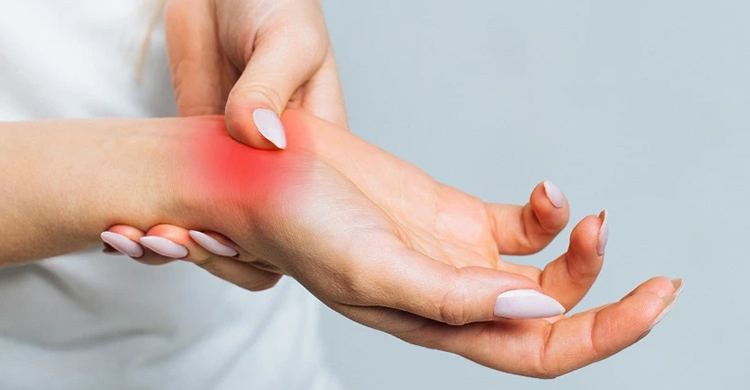
What is a Ganglion Cyst?
A ganglion cyst is a fluid-filled lump that develops near joints or tendons.
This fluid originates from synovial fluid, which normally surrounds joints and tendons. Its function is to lubricate and cushion them during movement. This condition grows from the joint or tendon sheath and is benign in nature.
These cysts most commonly occur in the hand area but can also develop in the shoulder, elbow, hip, knee, and foot.
They are usually round or oval in shape with sizes ranging from that of a pea to larger than a grape, up to the size of a golf ball. Cysts can enlarge with activity.
Causes of Ganglion Cysts
The exact cause of ganglion cysts is still unknown. Some theories suggest that cysts can develop after something injures a joint, causing tissue to leak or protrude.
However, most researchers currently suspect that this condition develops from mesenchymal cells in the synovial capsule junction, as a result of continuous micro-injury.
Repeated injuries to the capsular structure and supporting ligaments appear to stimulate fibroblasts to produce hyaluronic acid, which accumulates to produce a jelly-like mucin.
Risk Factors for Ganglion Cysts
There are also several factors that can increase the risk of someone developing a ganglion cyst, including:
- Gender and age. This condition can affect anyone, but it most commonly occurs in women aged between 20 and 40 years.
- Osteoarthritis. Individuals with arthritis in the joints closest to the nail are at higher risk of developing a ganglion cyst near those joints.
- Joint or tendon injuries. Joints or tendons that have been injured in the past are more likely to develop this condition.
Symptoms of Ganglion Cysts
This condition can appear as a lump, often in the hand area or other parts of the body. Other symptoms include:
- Pain.
- Numbness.
- Muscle weakness.
- Weakened grip.
- Reduced joint movement.
Diagnosis of Ganglion Cysts
Doctors typically diagnose ganglion cysts by performing a physical examination. The appearance and location of the lump (such as on the wrist or finger) can already indicate the presence of the cyst.
Doctors may also shine a light through the lump to see if it is translucent (most are). In some cases, doctors may take a sample from inside the lump (biopsy) for further analysis.
In rare cases, X-rays may be recommended to determine the cause of your symptoms. Ultrasound can also distinguish between solid masses and cysts.
Complications of Ganglion Cysts
Ganglion cysts are not dangerous. They are benign masses, meaning they will not spread to other areas. This condition is not cancerous.
It also very rarely causes permanent disability. Cysts that do not heal on their own and are symptomatic can almost always be managed by a doctor with surgery.
If the cyst does not heal even after surgery (which rarely happens), revision surgery may be performed to remove the cyst again.
After the cyst is removed, most patients experience a reduction in symptoms.
Treatment for Ganglion Cysts
Ganglion cysts can disappear on their own without treatment.
Treatment is necessary if there is pain and other symptoms that interfere with body movement.
Treatment options for ganglion cysts include:
-
Splinting
Splinting the wrist or finger aims to provide support and reduce pressure on the area affected by the ganglion cyst.
This treatment can help reduce pain and minimize pressure on the cyst.
-
Draining fluid from the lump with a needle (aspiration)
Aspiration involves draining fluid from inside the ganglion cyst using a needle. Although simple and generally painless, this procedure can provide temporary relief.
However, it’s important to note that cysts can reappear after aspiration, so if the cyst reoccurs, surgery may be necessary.
-
Injecting steroid into the joint
Injecting steroid into the joint can help reduce inflammation and swelling.
Steroids have anti-inflammatory effects that can alleviate symptoms such as pain and discomfort.
However, steroid use is usually a last resort when other treatment efforts have failed.
-
Surgery
Surgery is a last resort if conservative treatment is not effective or if the cyst reappears after aspiration.
This procedure involves removing the cyst and can be done under local or general anesthesia, depending on the need.
Although surgery can successfully remove the cyst, there are risks of side effects such as postoperative pain, infection, scar tissue formation, joint motion limitations, and the possibility of cyst recurrence.
Treatment options should be carefully considered after in-depth discussion with a medical professional.
However, Can Ganglion Cysts Recur After Healing? Learn more about it.
Prevention of Ganglion Cysts
There is no specific way to prevent ganglion cysts because the cause is still unknown.
However, a deeper understanding of the Various Causes of Ganglion Cysts can help you prevent them.
If a cyst appears, do not press or puncture it with a needle. Instead, monitor the condition of the cyst to see if it enlarges. Use a splint if recommended by a doctor.
When to See a Doctor?
Lumps that appear on the body should be examined to determine the cause.
If diagnosed with a cyst, it’s advisable to return to the doctor if the ganglion cyst becomes larger or more painful, the cyst swells and turns red, pus drains from the lump, numbness occurs in the affected area, and fever develops.
Doctors who can be consulted regarding ganglion cysts include general surgeons.




